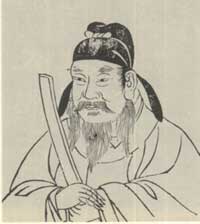 Liu Gongquan (778-865), courtesy name Chengxuan, was born in Huayuan, Jingzhao (now Yaoxian County, Shaanxi Province). He was fond of learning when he was young, and was able to write poems at the age of twelve. Because he was good at calligraphy, he was favored by Emperor Mu Zong Li Heng and was called to be a bachelor of calligraphy in the Hanlin Academy. Liu Gongquan is the most famous calligrapher in regular script. He is as famous as Yan Zhenqing and is known as Yan Liu. He followed the calligraphy techniques of Wei and Jin, followed those of the early Tang Dynasty, and was influenced by Yan Zhenqing. He created his own Liu School between the Jin people's Jin Mei and Yan Shu's grace and majesty. Its charming and vigorous calligraphy can be compared with the vigorous and generous style of Yan's calligraphy, and it was praised by later generations as "Yan's sinews and willow bones".
Liu Gongquan (778-865), courtesy name Chengxuan, was born in Huayuan, Jingzhao (now Yaoxian County, Shaanxi Province). He was fond of learning when he was young, and was able to write poems at the age of twelve. Because he was good at calligraphy, he was favored by Emperor Mu Zong Li Heng and was called to be a bachelor of calligraphy in the Hanlin Academy. Liu Gongquan is the most famous calligrapher in regular script. He is as famous as Yan Zhenqing and is known as Yan Liu. He followed the calligraphy techniques of Wei and Jin, followed those of the early Tang Dynasty, and was influenced by Yan Zhenqing. He created his own Liu School between the Jin people's Jin Mei and Yan Shu's grace and majesty. Its charming and vigorous calligraphy can be compared with the vigorous and generous style of Yan's calligraphy, and it was praised by later generations as "Yan's sinews and willow bones".
Liu Gongquan has many handed down works. The handed down steles include "Diamond Sutra Carved Stone", "Mysterious Pagoda Stele", "Fengsu Stele" and so on. Among them, "Diamond Sutra Engraved Stone", "Mysterious Tower Stele" and "Shence Army Stele" best represent his regular script style. Liu Gongquan's cursive scripts include "Fu Shen", "Sixteen Days", "Hui Xiang Tie", etc. Their style still inherits the Wang family's style, with rigorous structure and free and natural style. There are also ink inscriptions "Mengzhao Tie" and "Wang Xianzhi's postscript to send pears". "Mengzhao Poster" on white linen paper, seven lines, twenty-seven characters. Now in the Palace Museum. His book was once engraved in the "Sanxitang Dharma Notes" of Qianlong, and he said that "the ecology is in danger, and the strength is on the right." The body posture is slightly graceful, vigorous and elegant. In addition, there is a "Purple Silk Qing Tie" in "Lanting Xu Tie", the text is different, Hanlin does not call it "Chu Shou", so it is suspected to be fake, and it must be drafted by a master in the late Tang and early Song Dynasty.








